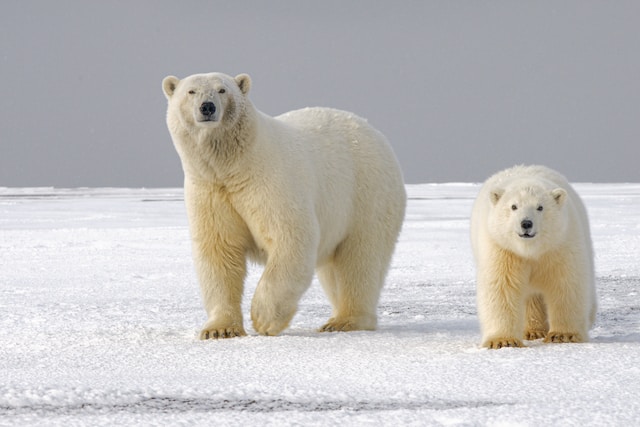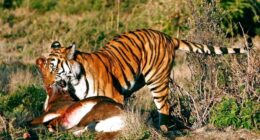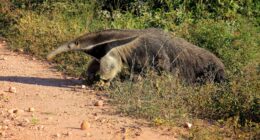Polar bears are adapted to life in the Arctic and have unique physical characteristics such as a white coat and webbed paws that make them excellent swimmers. Grizzlies, on the other hand, can be found across North America in various habitats including forests and grasslands.
Polar Bears
(Photo by Hans-Jurgen Mager on Unsplash )
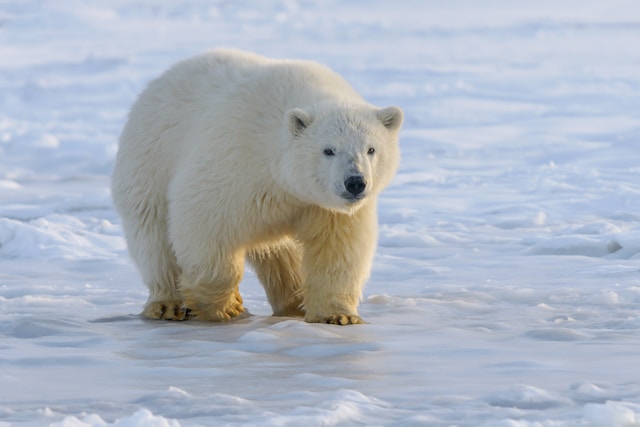
Polar bears are one of the most iconic animals found in the Arctic region. They are known for their thick white fur coat and massive size, making them an imposing presence in their habitat. These bears can grow up to 10 feet tall and weigh over 1,000 pounds! Despite their size, polar bears are excellent swimmers and can swim for hours without getting tired.
One thing that sets polar bears apart from other bear species is their diet. Polar bears primarily feed on seals, which they hunt by waiting patiently near breathing holes or cracks in the ice before ambushing them with lightning-fast strikes. This hunting strategy requires immense patience and precision.
Another fascinating aspect of polar bear behavior is how they mate. Unlike other mammals that have a fixed mating season, polar bears mate at any time during the year as long as there’s enough food available to support pregnancy. Females usually give birth to cubs in winter dens they’ve dug into snowdrifts or earth mounds.
In addition to being remarkable hunters and mothers, these magnificent creatures also face significant threats due to climate change affecting their habitats’ availability due to melting sea ice levels. The future survival of this species relies heavily on our ability as humans to combat global warming effectively.
Grizzlies
(Photo by Zdeněk Macháček on Unsplash )
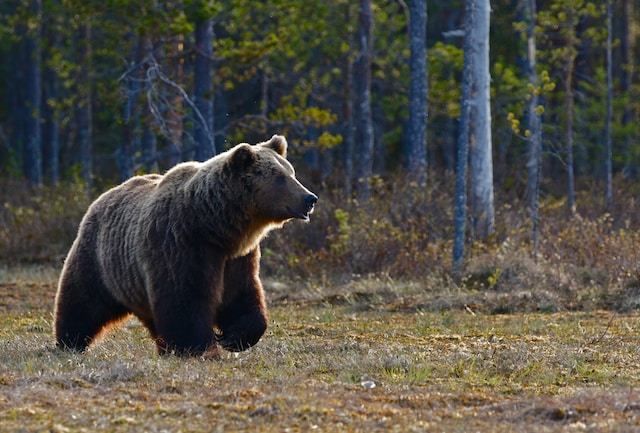
Grizzlies are one of the most iconic animals in North America and they have been a part of indigenous cultures for centuries. These massive bears can weigh up to 600 pounds and stand over six feet tall on their hind legs, making them an impressive sight.
One key difference between grizzlies and polar bears is their habitat. Grizzly bears can be found across much of North America, from Alaska down through Canada and into parts of the contiguous United States. They often live in forests near rivers or streams where they can find plenty of food.
Grizzlies have a varied diet that includes berries, nuts, roots, fish, small mammals like rodents, and occasionally larger prey like elk or moose. They are opportunistic eaters who will take advantage of whatever food sources are available in their environment.
Despite their fearsome reputation as apex predators, grizzly bears generally avoid confrontation with humans when possible. However, if they feel threatened or cornered they will defend themselves aggressively using powerful jaws and sharp claws.
Grizzly bears are fascinating creatures with a unique role to play in the ecosystems where they live. While respecting their power and potential danger is important for human safety when sharing space with these wild animals, we should also appreciate the vital role that grizzlies play in our world’s natural diversity.
Polar Bear Vs. Grizzly – Key differences
When it comes to bears, two of the most popular species are polar bears and grizzlies. While they share a few similarities, there are also some key differences that set them apart.
One of the most obvious differences between these two bears is their physical appearance. Polar bears have white fur, which helps them blend in with their snowy environment. Grizzly bears, on the other hand, have brown fur that can range from light blonde to dark black.
In terms of size, polar bears tend to be larger than grizzlies. A fully grown male polar bear can weigh up to 1,500 pounds and stand over ten feet tall when on its hind legs. In contrast, a male grizzly typically weighs around 600 pounds and stands about six feet tall.
Another major difference between these two species is their habitat. Polar bears live exclusively in the Arctic regions of North America and Eurasia where they hunt for prey like seals near sea ice formations. Grizzlies are found throughout North America including Alaska where they inhabit forests or grasslands as opportunistic omnivores feeding on both plants and animals.
While both species are known for being formidable predators in their respective environments – with the polar bear being considered one of strongest land mammals – each has its own unique set behaviors when it comes to hunting strategies or engaging human beings who enter into their habitats
Though whether you prefer the icy plains of Canada’s Northwest Territories or deep within an Alaskan forest; either way exploring nature could mean running into one –or maybe even both– magnificent creatures at some point!
Is polar bear the strongest bear?
The polar bear is one of the largest and most powerful predators on land. It can weigh up to 1,500 pounds and reach a length of over ten feet. When it comes to strength, however, it’s not clear whether or not the polar bear is the strongest.
Some people believe that grizzly bears are actually stronger than polar bears. They argue that grizzlies have more muscle mass and are better equipped for close combat. Grizzlies are also known for their aggressive behavior and have been observed fighting off wolves and other predators.
On the other hand, others argue that polar bears are stronger due to their ability to swim long distances in icy waters. This requires incredible endurance and strength, as well as an efficient body design adapted to swimming such as webbed front paws which act like paddles.
Ultimately, determining which bear is truly the strongest would require a complex analysis taking into account various factors including size, weight, muscle mass distribution etc.
What we do know for certain is that both polar bears and grizzly bears must be respected as incredibly powerful animals with unique adaptations suited for their respective habitats!
Are polar bears aggressive?
Polar bears are often portrayed as aggressive animals in popular culture, but is this really the case? The answer is not so straightforward.
While polar bears are indeed powerful predators and should be treated with caution, they are not inherently aggressive towards humans. In fact, most encounters between humans and polar bears end peacefully without any harm to either party.
However, it’s important to note that polar bears can become more aggressive if they feel threatened or provoked. This is especially true when a mother bear feels her cubs are in danger. In such situations, it’s best to give them plenty of space and avoid confrontation.
It’s also worth noting that climate change has led to an increase in human-polar bear interactions as melting ice forces the animals onto land in search of food. As a result, it’s important for humans to take steps to reduce their impact on polar bear habitats and minimize the risk of conflict.
While polar bears can exhibit aggression under certain circumstances, they are generally not dangerous unless provoked or threatened. It’s up to us as humans to respect their space and take action to protect their habitat for both our safety and theirs.
Polar Bear Vs. Grizzly Bears – Habitat
Polar bears and grizzly bears have very different habitats. Polar bears are found in the Arctic, while grizzly bears are found in North America.
The Arctic is a harsh environment with freezing temperatures, icy winds, and little vegetation. This means that polar bears have adapted to survive in these extreme conditions by building up layers of fat to keep them warm and hunting for seals on the ice.
Grizzly bears, on the other hand, live in forests or mountains where there is more vegetation and prey sources such as salmon or berries. They hibernate during winter months when food is scarce.
While both species may encounter each other at times due to climate change melting sea ice which leads polar bear migration towards forested areas where grizzlies live; they generally do not share habitats as they have evolved differently to suit their respective environments.
It’s important to note that habitat loss due to human activity affects both species’ survival rates drastically – from oil drilling near coastal areas where arctic animals hunt for food leading into pollution to deforestation resulting from logging activities which destroy crucial ecosystems essential for wildlife living within it including Grizzlies among others.
Polar Bear Vs. Grizzly Bears – Diet
Both polar bears and grizzly bears are carnivores, but their diets differ greatly due to their respective habitats. Polar bears predominantly feed on seals, which they hunt by waiting at the edge of sea ice or breaking through it to reach them. They also scavenge from carcasses of whales and other marine mammals when available.
Grizzly bears, on the other hand, have a diet that is more varied than polar bears. Their diet consists of berries, roots, tubers in summer; nuts and fruits in fall; fish like salmon during spawning season; rodents like ground squirrels for most part of the year; carrion (dead animals) when available; and large ungulates like moose or caribou mainly in autumn.
Polar bear’s adaptations allow them to survive solely on fatty meat with extremely high caloric content. Grizzlies too need a lot of energy to maintain themselves throughout winter hibernation period so they consume food with high fat content along with vegetation comprising small proportion of their overall diet.
Both polar bear and grizzlies rely heavily on fat-rich food sources but their starkly different habitats shape what they eat differently throughout the year.
Polar Bear Vs. Grizzly Bears – Behavior
Polar bears and grizzly bears have different behaviors that are adapted to their respective habitats. Polar bears, for instance, spend most of their time alone roaming around the Arctic sea ice looking for food. They are excellent swimmers and can cover long distances in cold waters while hunting seals.
Grizzly bears, on the other hand, tend to be more social animals and live in groups or families known as clans. They inhabit forested areas and usually feed on berries, nuts, roots, insects and small mammals.
When it comes to aggression levels towards humans, polar bears pose a greater threat compared to grizzlies due to their natural habitat being closer to human settlements. However, both bear species should never be approached closely or provoked under any circumstances as they remain wild animals with unpredictable behavior.
Additionally, polar bears have been known to display aggressive mating behavior during springtime where males may compete aggressively for female mates leading up to violent fights between them.
Both bear species exhibit unique behaviors that make them formidable predators who command respect when encountered in the wild.
Featured Image By – Hans-Jurgen Mager on Unsplash
